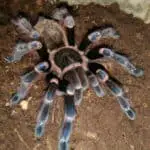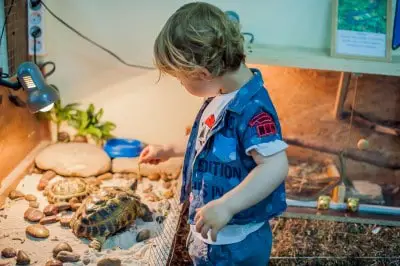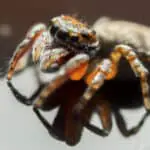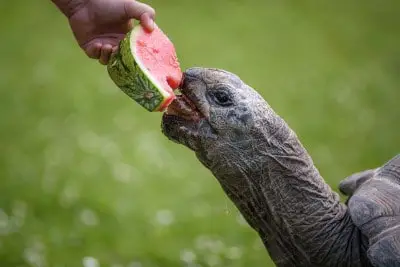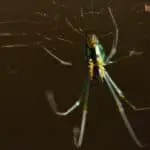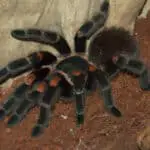Spiders are quite easily one of the best and easy to look after pets. They are low-maintenance and do not ask for a lot.
However, this does not mean that they can be left to their own devices. We still need to look after them and provide them with some basics. One of those fundamentals is water.
However, to a lot of people, that would sound very strange. Spiders and water do not sound like a good combination. And some people may wonder, do spiders actually drink water?
Spiders do drink water. Spiders get their water mainly from their prey, but they can drink water from the morning and evening dew, accumulated puddles of water, and more. By drinking water, spiders stay hydrated and healthy. If spiders do not have access to water, they can dehydrate and die.
In this article, I will provide you with all the information about spiders and water. In the end, you will have a better understanding of those little fellows and their thirst for water.

Do All Spiders Have to Drink Water?
Many beginner spider owners will find this fact surprising, but, yes, spiders do drink and need a regular intake of water.
You may not be able to frequently catch them drinking water; however, they most certainly do drink it. It depends on what kind of spider you have, too.
For example, if you have a tarantula—they are nocturnal creatures—and the odds of catching it taking a sip from its water bowl during the day are extremely low.
All spiders need to drink water. However, how much water they need will vary on the spider’s species and the ambient conditions.
Generally speaking, spiders, even the bigger ones, do not drink a lot of water.
All you need to do is make sure that your spider has a water dish that is always kept clean and filled with fresh water. There is nothing more that you need to worry about. When your spider gets thirsty, it will go and drink from the water.
There is no reason why your spider cage or vivarium should not have a water dish.
Even if you do not have a suitable water dish at the moment, you can always use a bottle cap or some other small container that can hold water. A good rule of thumb is to use a water dish that is no bigger than the spider’s leg span as the smaller species can drown.
Some people choose to mist the vivarium or keep parts of the substrate slightly damp instead of having a water dish.
However, this is not a good practice because some spider species do not like damp substrate; some people may also overmist the vivarium turning it into an excellent breeding ground for mites and mold.
As you are refilling the water bowl, make sure not to splash water around it. Spiders may use the area around the water bowl to dump waste products, and this, in combination with moisture, can lead to infestations.
How Long Can Spiders Go Without Water?
How long spiders can go without water will vary from species to species. Some may be able to survive long periods of time without water, while others will not survive even a single day.
Some brown recluse spiders, for example, can survive surprisingly long periods of time without water. Brown recluse spiders kept in relatively big plastic cages may survive up to ten months without water and food.
Some tarantulas, on the other hand, may survive no more than one to three weeks without water.
This is a question that has no concrete answers. It all depends on the ambient conditions like the temperature and humidity, the spider, its age, species, and how well it has fed.
It might interest you to know that one of the most crucial moments when spiders will need to have access to plenty of water is when they molt.
Misting can also work in this scenario, but it is not a reliable way to keep a spider well hydrated. We can get busy with our daily lives, and it can be very easy to forget to mist your spider on time—the results can be pretty bad and even lead to the spider’s death.
A simple water bowl will ensure that your spider can drink fresh water whenever it decides it is thirsty enough.
How Do Spiders Drink Water?
When a spider feels thirsty, it will approach the water and put its legs and pedipalps near or in the water bowl. It will put its front parts where the mouth is down (the chelicerae and fangs) and proceed to drink the water.
Spiders drink water by using their muscles to suck the fluid. (It is similar to how you would drink water through a straw.)
Spiders drink water very slowly. In fact, spiders can drink water for several minutes. The bigger species like the tarantulas can drink water for several hours. For example, severely dehydrated tarantulas may drink for more than 5 hours.
Many tarantula owners actually get scared when they see their tarantula drinking water for the first time, thinking it might have died, because parts of its body will be in the water, and it will not move at all.
You can see how a tarantula drinks water in this very short and cool video:
Spiders can also drink water that has accumulated and been caught in their web. The video below is a good example of how a spider will drink water that has been caught in its web.
Do Spiders Get Dehydrated?
If spiders do not have access to water, they will eventually dehydrate and die.
A dehydrated spider looks undersized and skinny. Their abdomen will shrink, shrivel, and become wrinkled. Sometimes the spider will also stay curled up. It will not move much and be very lethargic.
This is why it is recommended to monitor how much water your spider has in its water bowl.
During the summer, due to the higher temperatures, the water may evaporate faster. Even in winter, water continues to evaporate—especially if you have the heater on. Also, the lower the relative humidity, the faster the water will evaporate.
If your spider gets dehydrated, you may need to give it water yourself. This can be done by using an eyedropper, a medical dropper, or a syringe without the needle.
Fill the dropper or the syringe with water, gently flip your spider on its back, and drip a small globule of water in its mouth. Wait for the spider to suck the water in before giving it another drop of water. Usually, one to three small drops of water will be more than plenty.
In addition to that, you can then put the spider next to a damp paper towel or sponge so that the mouth area is almost touching them
To see an excellent hands-on example of hydrating a dehydrated spider, check out this neat video below.
A few hours after the spider has been hydrated properly, it should start showing symptoms of improvement.
What Water Should Spiders Drink?
It is recommended to use bottled water. You can buy a bigger gallon jug as it is less expensive than buying smaller water bottles. It also reduces the plastic waste that goes to the landfill.
However, plastic water bottles are known to leach BPA, phthalates, and other harmful chemicals, which may potentially be dangerous to spiders.
Tap water’s quality will vary from place to place, including its hardness, and additives.
Some people do give their spiders tap water, which may be considered okay in most cases. However, with all the chlorine, chloramine, fluoride, and other potential contaminants and chemicals found in tap water, it may not be a healthy choice for the spiders.
After all, human bodies are larger and may be able to better cope with the chemical in the water than spiders.
Tap water also tends to leave water stains, which tend to accumulate, something that does not happen with bottled water. If you are giving tap water to your spider, it may be worth using a stainless-steel or ceramic water dish as they are easier to clean.
Where Do Spiders Get Their Water From in the Wild?
Spiders drink water from accumulated puddles created by the rain and dew that has formed on the ground, the vegetation, or on their webs. They can also get some water from the humidity in the air.
For example, some desert spiders will cover their burrows with a web that will catch and keep low amounts of water. Some spiders may even eat nectar. And others will opt for eating their webbing in the morning to consume the moisture that it has caught.
Spiders get a good portion of their water requirements from their prey. This applies to both wild and pet spiders.
Most of the pet spiders will be fed at least once or twice per week, which—depending on the food they are supplied with—will provide them with some water.
However, even then, pet spiders should always be provided with a water bowl, just to be on the safe side, since if they feel a little more thirsty, they can immediately go and drink some water.
(The water bowl can also be used as means of regulating the humidity in the cage. Good ventilation is also vital.)
And lastly, some spiders like the diving bell spider are a different case altogether because they live underwater—I am sure they are most definitely not worried about not getting enough water in their diet.
Read more: Can Spiders Drown in Water



